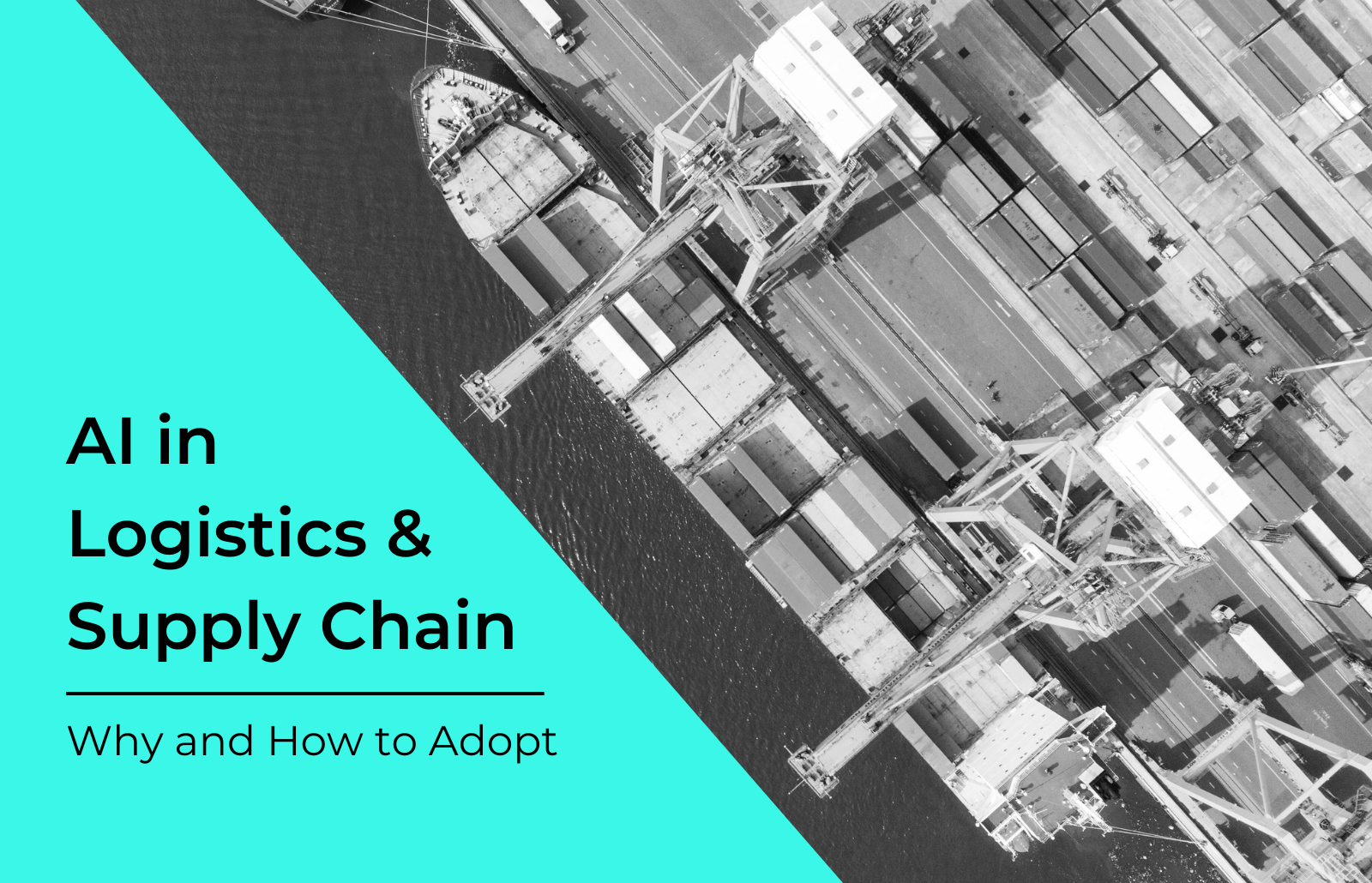The world of logistics is undergoing a revolution driven by artificial intelligence (AI). Gartner forecasts a twofold increase in machine automation within supply chain operations over the coming five years. Simultaneously, projections indicate a substantial surge in global spending on IIoT Platforms, expected to skyrocket from $1.67 billion in 2018 to $12.44 billion by 2024, demonstrating a remarkable 40% compound annual growth rate (CAGR) over seven years.
AI is transforming how businesses manage their supply chains, leading to increased efficiency, cost savings, and improved customer satisfaction. This blog post will delve into the various applications of AI in logistics, showcase real-world examples, and provide a roadmap for businesses looking to adopt this transformative technology.
What Does AI Mean for Logistics and Supply Chain?
Artificial Intelligence (AI), in the supply chain realm, isn’t a single technology, but rather a confluence of tools and techniques that leverage data and machine learning to optimise various aspects of the flow of goods. Here’s a breakdown of what AI in the supply chain truly entails:
The Power of Data and Machine Learning:
- At its core, AI in the supply chain is fueled by data. Logistics generates vast amounts of data, including historical sales records, real-time traffic information, sensor data from vehicles and warehouses, and customer information.
- Machine learning, a subfield of AI, allows computers to learn from this data without explicit programming. These algorithms identify patterns, relationships, and trends within the data, enabling them to make predictions and recommendations.
Applications Across the Supply Chain Spectrum:
AI isn’t a one-trick pony in logistics. It has applications across various stages of the supply chain, including:
- Demand Forecasting: AI algorithms analyse historical sales data, customer demographics, and even social media trends to predict future demand for specific products. This allows companies to optimise inventory levels and avoid stockouts or excess inventory.
- Warehouse Management: AI-powered robots can automate repetitive tasks in warehouses, such as picking and packing orders. This frees up human workers for higher-value activities and improves overall warehouse efficiency and accuracy.
- Predictive Maintenance: Imagine being able to predict when a truck component is likely to fail. AI can analyse sensor data from vehicles to identify potential maintenance issues before they become breakdowns. This proactive approach keeps your fleet running smoothly and minimises downtime.
- Inventory Optimization: AI helps maintain optimal inventory levels by analysing sales trends, lead times, and supplier capabilities. This reduces the risk of stockouts and the associated costs of lost sales, while also minimising storage needs for excess inventory.
Beyond Efficiency: The Broader Impact of AI
The potential benefits of AI in the supply chain extend beyond just efficiency and cost savings. Here are some additional advantages:
- Improved Safety: AI can analyse driver behaviour and identify patterns that could lead to accidents. This allows for targeted training interventions and improved safety protocols, fostering a safer work environment for drivers.
- Sustainability Champion: AI-optimised routes lead to shorter travel distances and less fuel consumption, reducing a company’s carbon footprint. Additionally, AI can help optimise packaging by recommending the most space-efficient configurations, minimising waste materials.
- A More Agile Supply Chain: By enabling real-time data analysis and faster decision-making, AI fosters a more responsive supply chain. Companies can adapt to sudden changes in demand or unexpected events, ensuring a smooth flow of goods and minimising disruptions.
AI in the supply chain is more than just a buzzword. It’s a powerful suite of tools and techniques that leverage data and machine learning to optimise logistics operations, leading to a more efficient, cost-effective, and sustainable supply chain.
Examples of AI in Logistics
AI encompasses a range of technologies, including machine learning, natural language processing, and computer vision. These technologies are being harnessed in logistics to automate tasks, optimise processes, and gain valuable insights from data. Here’s a glimpse into how AI is reshaping the industry:
- Data Insights and Reports: Logistics generates massive amounts of data. AI can analyse this data to identify trends, predict demand fluctuations, and optimise inventory management. For instance, AI can forecast seasonal spikes in demand, allowing companies to pre-stock inventory and avoid stockouts.
- Route Optimization: Say goodbye to static delivery routes. AI algorithms can analyse real-time traffic data, weather conditions, and even driver availability to plan the most efficient delivery routes. This reduces fuel consumption, minimises delivery times, and lowers overall transportation costs. Imagine a delivery company using AI to constantly adjust routes based on live traffic updates, ensuring drivers avoid congested areas and deliver packages faster.
- Customer Support: AI-powered virtual assistants can answer frequently asked questions, track shipments, and even resolve basic customer issues 24/7. This frees up human customer service representatives for more complex inquiries, leading to a more efficient and responsive customer support system.
Check out this AI Virtual Assistant development case study, where our team built an ai-powered chatbot for our client who wanted to support customer success teams across different geographies and languages:
- IoT Integration for Driver and Vehicle Diagnostics: The Internet of Things (IoT) allows sensors to be placed on vehicles and throughout warehouses. AI can analyse the data collected by these sensors to monitor vehicle health, predict maintenance needs, and prevent breakdowns. This proactive approach keeps fleets running smoothly and minimises downtime.
- Automated Maintenance: AI is used to automate routine maintenance tasks in warehouses. For example, AI-powered robots can be deployed to automatically recharge forklifts or replenish picking bins. This frees up warehouse staff to focus on higher-value activities.
- Predictive Maintenance in Action: A logistics company uses AI to analyse sensor data from their trucks. This data includes engine performance metrics, tyre pressure, and even driving patterns. By analysing this data, the AI can predict when a component is likely to fail and schedule preventive maintenance. This proactive approach prevents breakdowns on the road, reducing downtime and ensuring deliveries arrive on time.
These are just a few examples of how AI is transforming logistics. As AI technology continues to evolve, we can expect even more innovative applications to emerge in the years to come.
The Road to AI Adoption in Logistics: A Step-by-Step Guide
The logistics industry stands to gain significant advantages by adopting AI, but navigating the path to successful implementation requires careful planning and execution. Here’s a detailed breakdown of the steps involved:
1. Identifying Needs and Goals
- Conduct a thorough analysis of your current logistics operations. Identify bottlenecks, inefficiencies, and areas where errors frequently occur.
- Pinpoint areas that could benefit most from AI’s capabilities. Are you struggling with high transportation costs due to inefficient routes? Perhaps demand forecasting is a challenge leading to stockouts or excess inventory.
- Set clear and measurable goals for your AI adoption. Do you aim to achieve a 10% reduction in delivery times or a 5% decrease in transportation costs? Quantifiable goals will help you track progress and measure the success of your AI implementation.
2. Building a Strong Data Foundation
- AI is data-driven. Ensure you have a robust system in place for collecting and managing logistics data. This data could include historical sales records, real-time traffic information, sensor data from vehicles and warehouses, and customer information.
- Data quality is paramount. Cleanse your data to remove inconsistencies and errors. Inaccurate data will lead to unreliable AI models and hinder the effectiveness of your entire system.
- Invest in data governance strategies. Establish clear protocols for data access, security, and compliance with relevant privacy regulations.
3. Partnering with the Right AI Experts
- The logistics industry has specific needs and challenges. Don’t settle for generic AI solutions. Seek out partners with proven experience in developing and deploying AI specifically for logistics applications.
- These partners should have a deep understanding of your industry and its unique data landscape. They can help you choose the most suitable AI tools and technologies for your specific needs.
- Look for partners who offer ongoing support and guidance. AI is an evolving field, and your chosen partner should be able to help you adapt and scale your AI implementation over time.
4. Starting Small and Scaling Up
- Don’t attempt to automate everything at once. Begin by implementing AI in a targeted area with a well-defined scope. This allows you to test the technology, identify any challenges, and refine your approach.
- A pilot project in a specific warehouse or on a particular delivery route can be a good starting point. Once you achieve success in this limited scope, you can gradually scale up AI adoption to other areas of your logistics operations.
- By following a measured approach, you can minimise risks, build confidence within your organisation, and ensure a smoother transition towards a more AI-powered logistics system.
5. Change Management and Employee Training
- AI adoption will likely necessitate changes in workflows and employee roles. Be prepared to address employee concerns and provide comprehensive training programs.
- Equip your workforce with the necessary skills to understand, collaborate with, and leverage AI effectively. This will help ensure employee buy-in and foster a culture of innovation within your organisation.
6. Embrace Continuous Improvement
- The field of AI is constantly evolving. Stay up-to-date on the latest advancements and explore how new technologies can further optimise your logistics operations.
- Regularly monitor and evaluate the performance of your AI systems. Refine your approach based on ongoing data and adapt to changing business needs.
- By fostering a culture of continuous improvement and exploration, you can ensure your logistics operation remains at the forefront of AI-driven efficiency and innovation.
Unlocking the Benefits of AI in Logistics
AI in logistics unlocks a treasure trove of benefits that can transform your operations. Here’s a breakdown of how AI can drive innovation, enhance customer satisfaction, improve efficiency, generate significant cost savings and many more:
i) Innovation
- AI Fosters a Data-driven Culture: By leveraging vast amounts of data, AI helps identify hidden patterns and trends. This empowers logistics companies to develop innovative solutions for optimising routes, managing inventory, and streamlining warehouse operations.
- Automation Paves the Way for Creativity: AI automates repetitive tasks, freeing up human employees to focus on higher-level problem-solving and strategic planning. This fosters a more innovative environment where employees can channel their creativity towards developing new solutions and improving customer experiences.
ii) Customer Satisfaction
- Enhanced Delivery Times and Accuracy: AI-powered route optimisation ensures faster deliveries while minimising delays. Predictive maintenance helps prevent breakdowns, keeping deliveries on schedule.
- Real-Time Shipment Tracking and Proactive Communication: Customers gain peace of mind with real-time tracking powered by AI. AI can also be used to anticipate potential delays and proactively communicate with customers, managing expectations and fostering trust.
iii) Improved Efficiency
- Optimised Routes and Reduced Transportation Costs: AI algorithms analyse real-time traffic data and various factors to create the most efficient delivery routes. This reduces travel time, fuel consumption, and overall transportation costs.
- Streamlined Warehouse Operations: AI-powered robots can automate tasks like picking and packing, improving warehouse efficiency and accuracy. AI can also optimise warehouse layouts for smoother workflows and faster order fulfilment.
iv) Cost Savings
- Reduced Labour Costs: While AI automates tasks, it doesn’t replace human employees entirely. It frees them up for higher-value activities, optimising labour utilisation and potentially reducing overall labour costs.
- Inventory Optimisation and Minimise Stock Outs: AI-powered demand forecasting helps maintain optimal inventory levels, reducing the risk of stockouts and the associated costs of lost sales. Additionally, AI helps minimise the need for excess inventory storage, leading to further cost savings.
v) Safety First
AI can analyse driver behaviour and identify patterns that could lead to accidents. It allows for targeted training interventions and improved safety protocols, reducing accidents and fostering a safer work environment for drivers.
vi) Sustainability Champion
AI-optimised routes lead to shorter travel distances and less fuel consumption, resulting in a significant reduction in a company’s carbon footprint. Additionally, AI can help optimise packaging by recommending the most space-efficient configurations, minimising wasted materials.
vii) Predictive BI for Better Decision-Making
AI can analyse vast amounts of data to predict potential disruptions in the supply chain, such as weather events or port congestion. This foresight allows companies to proactively develop contingency plans, minimising delays and ensuring deliveries get through even when faced with unforeseen challenges.
viii) Empowering the Workforce
AI isn’t here to replace logistics workers; it’s here to empower them. By automating repetitive tasks, AI frees up employees to focus on more complex problem-solving, customer interaction, and strategic planning. This leads to a more skilled and engaged workforce.
ix) A More Agile and Responsive Supply Chain
AI allows for real-time data analysis and faster decision-making. This agility enables logistics companies to adapt to sudden changes in demand or unexpected events, ensuring a smooth flow of goods and minimising disruptions.
By implementing AI in these ways, logistics companies can not only achieve the traditional benefits of efficiency and cost savings, but also create a more sustainable, safe, and responsive supply chain that empowers their workforce and delivers a superior customer experience.
Under the Hood of AI in Logistics: How it Works
AI’s impact on logistics goes beyond a simple plug-and-play solution. It involves a multifaceted approach that transforms how companies build new products, improve existing ones, and modernise their infrastructure to support this powerful technology. Here’s a deeper dive into how AI works within the logistics landscape:
i). Building New AI-powered Products
- Identifying Needs and Data Collection: The journey begins with a thorough analysis of logistics operations. Bottlenecks, inefficiencies, and areas ripe for improvement are pinpointed.
- Data is King: Logistics data is meticulously collected from various sources. This includes historical sales records, real-time traffic information, sensor data from vehicles and warehouses, and customer information. Data quality is paramount, as any inconsistencies will lead to unreliable AI models.
- Choosing the Right AI Tools: Depending on the specific need, different AI tools are selected. Machine learning algorithms might be used for demand forecasting, while computer vision could be employed for automated package sorting in warehouses.
- Model Development and Training: Data scientists leverage the chosen AI tools to develop models or mature them through documentation and RAG. These models are trained on the collected data, allowing them to learn and identify patterns.
- Testing and Refinement: The developed AI models undergo rigorous testing in simulated environments or pilot programs. This ensures the models function as intended and produce accurate results. Based on testing outcomes, the models are further refined and optimised.
- Integration and Deployment: The final step involves seamlessly integrating the AI models with existing logistics systems. It may involve developing APIs (Application Programming Interfaces) or building custom software to ensure smooth data flow and communication between the AI models and the operational systems.
ii). Enhancing Existing Products with AI
In this case, you would need to look into your existing business products and processes, to see if implementing AI can increase the value of your offer noticeably. Some examples may include:
- Leveraging Machine Learning for Route Optimization: Existing route planning software can be enhanced by integrating machine learning algorithms. These algorithms analyse real-time traffic data, weather conditions, and even driver availability to constantly optimise delivery routes, leading to faster deliveries and reduced fuel consumption.
- Chatbots Powered by AI for Customer Support: Existing customer support systems can be strengthened by incorporating AI-powered chatbots. These chatbots can answer frequently asked questions, track shipments, and even resolve basic customer issues, freeing up human support agents for more complex inquiries.
iii). Modernising Infrastructure and Tech Stack for AI Adoption
- Cloud-based Infrastructure: Scalable and reliable cloud computing platforms are crucial for handling the vast amounts of data generated by logistics operations. Cloud infrastructure provides the resources needed to train and run AI models efficiently.
- API Integration: Modern logistics systems often rely on a complex web of applications and software. APIs facilitate seamless communication and data exchange between these systems and the AI models, ensuring smooth operation and data flow.
- Data Management and Security: Robust data management systems are essential. This involves establishing clear protocols for data access, security, and compliance with relevant data privacy regulations.
iv). Investing in People and Skills
- Data Science Expertise: Logistics companies need to invest in data science talent. These professionals possess the skills to develop, train, and maintain AI models, ensuring their effectiveness and continued learning capabilities.
- Change Management and Training: As AI transforms workflows, employee training is crucial. Employees need to understand how AI works, how to interact with it effectively, and how to leverage its capabilities to improve their work.
By implementing these strategies, logistics companies can leverage AI to build new products, enhance existing ones, and modernise their infrastructure. This paves the way for a future of intelligent logistics, characterised by efficiency, innovation, and a competitive edge in the ever-evolving global marketplace.
Concluding Thoughts
The integration of artificial intelligence (AI) into logistics and supply chain operations presents a compelling imperative for businesses seeking to thrive in an increasingly complex and competitive landscape. By harnessing the power of AI technologies, organisations can unlock unprecedented efficiency gains, optimise resource allocation, enhance decision-making processes, and ultimately drive significant cost savings.
Moreover, the adoption of AI offers a pathway towards greater agility, resilience, and responsiveness to evolving market demands and disruptions. Embracing AI in logistics and supply chain management is not merely a choice but a strategic necessity for companies aspiring to maintain a competitive edge and secure long-term success in today’s dynamic business environment. By embracing AI, logistics companies can gain a significant competitive edge and navigate the ever-evolving landscape of the industry.
Unlock the Power of AI in Your Logistics Operations With Zartis
The logistics landscape is undergoing a revolution driven by artificial intelligence (AI). At Zartis, we understand the transformative potential of AI and its ability to optimise your supply chain, streamline operations, and boost your bottom line.
We specialise in revolutionising logistics operations through cutting-edge technology solutions. Our professional team combines expertise in logistics management with advanced AI consulting services. By integrating artificial intelligence into their software solutions, we empower businesses to optimise their supply chains, enhance efficiency, and reduce costs. Whether you’re a small startup or a large enterprise, our custom logistics software solutions cater to your unique needs, ensuring seamless operations and streamlined processes.
Ready to elevate your logistics operations to new heights? Contact us today to learn more about how our innovative software solutions, coupled with Generative AI services at Zartis, can transform your business. Let us help you unlock the full potential of your supply chain and drive success in the digital age. Reach out now to schedule a consultation and take the first step towards revolutionising your logistics management!





